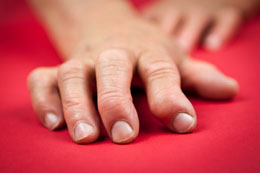Rheumatoid arthritis in hands affects the cell that lubricate the joints. Information related to rheumatoid arthritis affecting hands is discussed in the article below. Read on, to learn more...

As a person ages, the cartilages covering the bone surface tends to disappear as a result of wear and tear. This causes the joints to rub against one another. Thus causing inflammation of the joints leading to arthritis. There are different types of arthritis that can affect a person, of which rheumatoid arthritis is one. This is a systemic disease that can affect any part of the body. About two-thirds of patients are affected with rheumatoid arthritis of the hand and wrist.
What Causes Rheumatoid Arthritis?
Rheumatoid arthritis is a type of autoimmune disease that causes antibodies of the body to attack the body's own tissues. Antibodies tend to surround the cartilage and tissue around each joint. They damage these tissues and gradually lead to inflammation of the joint and bones near the joint. The commonly affected joints include, the fingers, thumbs, wrists, knees, feet and ankle joints. Less commonly affected joints include hips, shoulders, elbows and neck as well. This is a symmetrical disorder, that means, if joints of the right hand are affected; joints of the left hand will also be affected.
Rheumatoid Arthritis of the Hand
Rheumatoid arthritis mostly affects the joints in the hand. The antibodies produced affect the cells around the joints that help lubricate them. The synovium thus becomes inflamed and swollen, causing the tissues to stretch. This stretching of tissues causes other supporting structures like tendons and ligaments to stretch too. Thus, the joints become deformed and the joint cartilages erode. The person finds the joints appear red and hot to touch.
Types of Rheumatoid Arthritis of the Hand
Rheumatoid arthritis causes the hand to become deformed. These deformities affect in the fingers, thumbs as well as wrists. Some of these deformities include:
☛
Thumb Deformities:
- Boutonniere deformity (Type 1)
- Flexion deformity (Type 2)
- Swan neck deformity (Type 3)
- Abduction of the proximal phalanx and adduction of metacarpal (Type 4)
☛
Finger Deformities:
- Intrinsic plus deformity
- Mallet deformity
- Ulnar deviation of the fingers towards the little finger
- Boutonniere deformity
- Swan neck deformity
☛
Wrist Deformities
- Ulna bone dislocation dorsally
- Ulnar shift in the wrist bones
- Tendon rupture
- Metacarpals shifting towards the index finger radially
Symptoms of Rheumatoid Arthritis in Hand
The rheumatoid arthritis symptoms include pain, swelling and stiffness of hand joints. The stiffness increases especially in the morning after waking up. Other symptoms include:
- Presence of firm nodules on the fingers and elbow
- Collapse of the fingers
- Soft lump present on the back of the hand that can move when the fingers are straightened
- Inability to bend or straighten fingers due to tendon rupture
- Bending of the middle finger
- Swan neck fingers
- Bones of the wrist appear prominent
- Numbness and tingling in hand
- Crepitus, lock joint or snapping sound from joints
Diagnosing Rheumatoid Arthritis
Diagnoses of rheumatoid arthritis of the hand usually involves clinical examination of the patient, lab tests and x-rays. The appearance of the hand gives the doctor an idea as to which type of arthritis the patient is suffering from. X-rays help observe the erosion of joints, the decrease in spaces as well as swelling on the non-bony structures of the hand.
Treatment for Rheumatoid Arthritis
Rheumatoid arthritis has no cure as this is a chronic condition. However, the doctor may suggest medications to help relieve pain and slows down the joint deterioration. Medications like non-steroidal anti-inflammatory drugs (NSAIDs), steroids, disease-modifying anti-rheumatic drugs (DMARDs) and immunosuppressant. help reduce the pain, swelling, slow down the progression of the disease as well as suppressing the immune system. Apart from this, the patient is advised occupational therapy as well as physical therapy. If none of the medications and therapies help in slowing down the joint damage, the patient is advised surgery. These surgeries include total joint replacement, tendon repair, joint fusion and removal of joint lining.
Rheumatoid arthritis in hands is a debilitating condition. This condition affects women more than men ,and appears in people in the age group of 40 to 60 years. Speak to a doctor for more details and treatment options available for rheumatoid arthritis.


 As a person ages, the cartilages covering the bone surface tends to disappear as a result of wear and tear. This causes the joints to rub against one another. Thus causing inflammation of the joints leading to arthritis. There are different types of arthritis that can affect a person, of which rheumatoid arthritis is one. This is a systemic disease that can affect any part of the body. About two-thirds of patients are affected with rheumatoid arthritis of the hand and wrist.
As a person ages, the cartilages covering the bone surface tends to disappear as a result of wear and tear. This causes the joints to rub against one another. Thus causing inflammation of the joints leading to arthritis. There are different types of arthritis that can affect a person, of which rheumatoid arthritis is one. This is a systemic disease that can affect any part of the body. About two-thirds of patients are affected with rheumatoid arthritis of the hand and wrist.